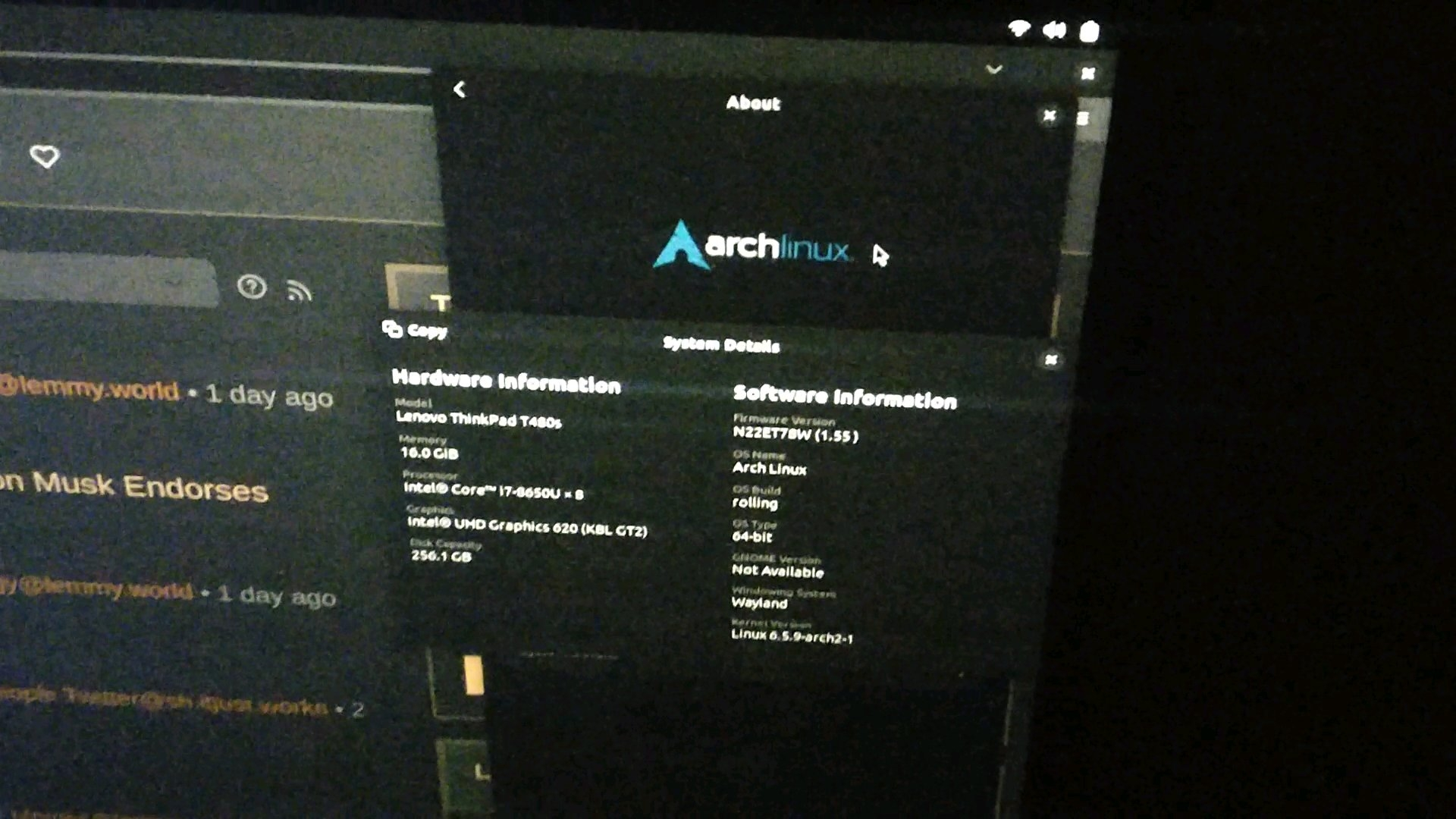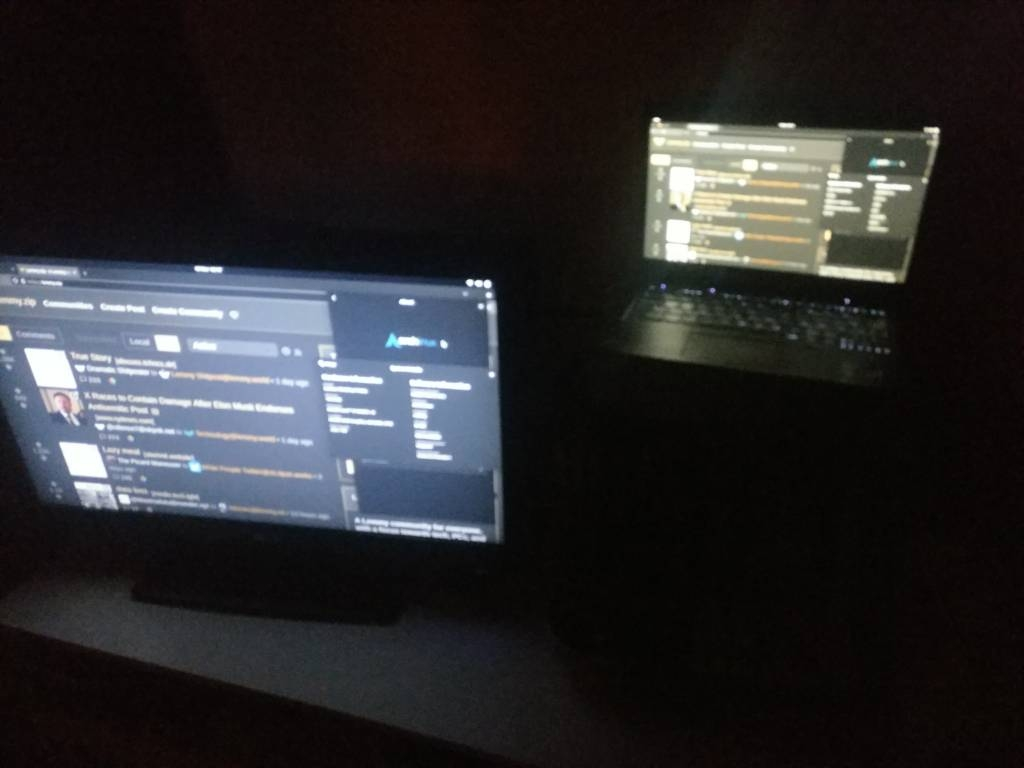Link to article: https://gist.github.com/probonopd/9feb7c20257af5dd915e3a9f2d1f2277?permalink_comment_id=4749746
This OUTDATED article gets posted all the time. The full story is the guy is a massive FreeBSD fan so he is trying to convince more people to keep on using Xorg because he wants to make sure it isn’t abandoned. Reason for that being that Wayland is built with Linux in mind and would not work under FreeBSD without a lot of effort bwing put in as it uses some Linux-specific components or libraries.
Let’s go through the article point by point:
Wayland is broken by design:
-
A crash in the window manager takes down all running applications: Yes, because the compositor IS the server, window manager AND compositor at the same time.
-
You cannot do a lot of things: What, like allowing Windows to see your keystrokes, which makes developing a keylogger absolutely trivial?
-
There is not /usr/bin/wayland: Yes, because Wayland is a set of protocols, which a bunch of projects can implement as few or as many of, as they see fit, thus avoiding the issue of “unmaintainable mess” that has plagued Xorg for years.
-
It offloads work to the window manager: Again, yes, that’s a part of its structure: do the protocols, then let the compositor implement them. That way, you have multiple implementations running simultaneously that are well integrated with their window managers and thus more efficient and performant. It also means that when a compositor suffers from too much cruft, we can just make a new one, while application developers wouldn’t really have anything to change because if their application works on Wayland, then it works on different compositors (unless it is made specifically for GNOME, or specifically for wlroots, like wlr-randr)
…so what works on DE 1, doesn’t necessarily work on DE 2: True, because oftentimes, it doesn’t need to. Not implementing features can lead to a more lean and streamlined software solution. However, sometimes features are necessary and only implemented in some compositors. This usually happens because the universal solution is not ready. KDE are often known to do this with Plasma and KWin.
- Wayland breaks screen recording applications: Correction: The following screen recording applications were not built to support Wayland (because Wayland is new to them or they just decided not to, or they were either too busy or too irresponsible enough to realise Wayland is coming, and has been for over 10 years. In defence of the devs, they probably wanted to make sure Wayland will become stable enough, but it has been the default even on Debian for many years now, so…
In terms of the applications, I’m not aware of many of them, and for this sort of application, I’m sire alot of work is required to change the graphical backend, so I understood that some smaller projects gave up, but OBS has been working on Wayland for quite a while. Is it perfect? I don’t think so, but back when Brodie Robertson was using Hyprland, he was recording his videos using OBS. This article is quite outdated.
- Wayland breaks screen sharing applications:
As the update shows, Jitsi now does work on Wayland.
Zoom only seemed to work on gnome, BUT if you open up the Link to the zoom issue and read through the comments, there is clearly a person that clearly states that they changed /etc/os-release from PureOS to debian and it worked for them, all because of some pointless limitations enforced by the Zoom developers. As the person posting the issue states “Currently, the zoom application has put an arbirtrary restriction on screensharing so it ONLY works on GNOME, when the api being used works on all wayland desktops.” Read that again. It’s a pointless restriction put there by the Zoom team because they couldn’t be bothered to test anything non-GNOME.
And the last issue is a problem with the article writer’s own appimage. I don’t know about that one.
- Wayland breaks automation software
As stated IN YOUR FACE, it is an application that works on X11 only. Yes, Wayland is not made to use such applications, but it doesn’t mean they can’t exist. Every heard of ydotool (remember that name)? Now you have.
Next up, we have 3 issues about GNOME and KDE global menus (1 for GNOME, 2 for KDE). From the little I know about global menus and using these projects, as well as considering that they are both incredibly stable on Wayland and Fedora KDE will be dropping Xorg completely, I think it’s safe to assume these issues have probably been fixed. Please correct me if I’m wrong.
-
Wayland breaks AppImages that don’t ship a special QT plugin: Great! Just ship the plugins then! Problem solved! Also, quote from the article: “However, there is a workaround: “AppImages which ship just the XCB plugin will automatically fallback to running in xwayland mode” (see below).”
-
Wayland breaks Redshift: Once again, a program built for Xorg doesn’t always work on Wayland. Especially if it works with the compositor, like a colour temperature control application, or a wallpaper setter. The article quotes that “Redshift does not support Wayland since it offers no way to adjust the color temperature” which is not true, as proven by Redshift alternatives like Gammastep.
-
Wayland breaks global hotkeys: I present to you: Hyprland (where you can get global hotkeys). Now, it is normally not allowed by design, as a security measure, but Hyprland has not allowed that to stop them from implementing a solution where you can choose keys that will be passed on to the application. Boom, problem solved. Unfortunately, it doesn’t seem to be implemented anywhere else, as far as I know.
-
Wayland does not work for XFCE: Come back to me in late 2024 after XFCE 4.20, which will introduce Wayland support, has been released. Also, https://wiki.xfce.org/releng/wayland_roadmap
-
Wayland does not work properly on Nvidia Hardware: It keeps on getting closer but is not there yet, or so I’ve heard. Apparently, the issue is with the proprietary drivers, as noveau works well. But I use AMD, so I’m only working off rumours and opinions here.
-
Wayland does not work properly on Intel hardware: Again, I’m using AMD, so I can’t confirm or deny this, but considering the Intel drivers are open source, and I’ve heard about many, many improvements made on the Intel side of things, I think it would be reasonable to assume it has been fixed.
Edit: As multiple Intel users have pointed out in the comments, there seem to be no issues on Wayland with Intel hardware.
-
Wayland prevents GUI applications from running as root: This one has been crossed out as the article writer admits there is a solution
-
Wayland is biased towards Linux and breaks BSD: Arguments seem valid, and I’m guessing, are correct. This one is likely true and will remain so for the foreseeable future.
Edit: And yet, it seems that there are Wayland compositors for FreeBSD, so the above might only be true for OpenBSD and others.
-
Wayland complicates server side decorations: From what I’ve heard, this is true, mainly something to do with some GNOME agenda, as the article states. I think that one is true.
-
Wayland breaks windows raising/activating themselves: The linked issue is closed and seems to be resolved. There is a mention of a WIP protocol at the time (2019) that woukd fix this. I had difficulty following the discussion, but I think this has been fixed.
-
Wayland breaks RescueTime: Because RescueTime depends on X11-only tools like xprop.
-
Wayland breaks window manager: What you’re describing is Wayland breaking X11-only tools for doing various tasks in a window manager. They are X11 tools, so of course they don’t work on Wayland. I’m not sure if there are alternatives, but I’d guess there probably are. I know for a fact that Xrandr has alternatives like wlr-randr and kanshi for wlroots.
-
Wayland requires {instert WM here} to implement Xorg-like functionality:Yes, it does.
Quote from article: "As it currently stands minor WMs and DEs do not even intend to support Wayland given the sheer complexity of writing all the code required to support the above features. "
DEs: GNOME, KDE, MATE, XFCE, Cinnamon, Budgie, Enlightenment, and recently even Pantheon have either announced to start work on, have started work on, or already support Wayland.
Window managers: Qtile is doing it. Xmonad wants to hire a dev to do it. Dwm has a spiritual successor called dwl. i3 has a drop-in replacement called sway. Openbox has 2 spiritual successors called labwc and waybox. Now you might notice one of the biggest WMs is missing on here: AwesomeWM, which is such a shame. The Awesome devs have said they would be okay with someone taking on that challenge (which has already been attempted, as evidenced by the existence of way-cooler), but it seems that they wouldn’t do it themselves.
As for the projects mentioned in the article, (JWM, TWM, XDM, IceWM) they are too small and obscure, and will likely fade away with Xorg.
-
Wayland breaks _NET_WM_STATE_SKIP_TASKBAR protocol I don’t know about that one, ao I’ll assume it is still the case. Edit: Ignoring the fact that the link is broken, it basically just links to a docs change where skipTaskbar is marked as unsupported on Linux. Link: https://github.com/electron/electron/pull/33226
-
Wayland breaks NoMachine NX The link points to a page that has this marked as “SOLVED, Released in version 8” so I’m guessing it has been solved.
-
Wayland breaks Xclip: As you said it yourself, Xclip is an X11 application, so it doesn’t work on Wayland. Of course it wouldn’t work on Wayland. With Wayland, we’re trying to prevent what happened with Xorg from happening again, or am I wrong?
Edit: As pointed out by some people in the comments, there are also alternatives to xclip like wl-clipboard.
-
Wayland breaks SUDO_ASKPASS: That link seems to point to the way this issue has been resolved so I don’t see your point.
-
Wayland breaks X11 atoms: I lack knowledge on the topic so will assume this to be a valid argument
-
Wayland break games: I’m 99% sure you can disable Vsync??? But I’m not a gamer. Also, WINE on Wayland is getting better and better. Soon enough, I hope the subpar performance will become better performance (when compared to Xorg)
-
Wayland breaks xdotool: Well, yes. There is ydotool, but you’re looking for a 1-to-1 replacement and I’m not sure if ydotool fits the bill for that.
-
Wayland breaks xkill: Well, yes. Again. It is an X application, so of course it does. Though for some reason I remember it working once on wayland. Must have been an xwayland app, or maybe I’m just misremembering this.
-
Wayland breaks screensavers: Yeah, that seems to be the case.
-
Wayland breaks setting the window position: That is a WIP for Plasma, not sure about any other projects, so assume true for anything else.
-
Wayland breaks color management: Not anymore. That is being actively worked on.
-
Wayland breaks DRM leasing: While not rhat familiar with the issue, my understanding of the topic is the article is correct: not all compositors support it.
-
Wayland breaks in-home streaming: Not familiar with this, so will assume true.
-
Wayland breaks NetWM/EWMH: Yeah, that seems to be the case.
-
Wayland breaks window icons: Yeah, that seems to be the case, as said in the article, when no .desktop files are used.
And that concludes my response to this article based on my fairly limited knowledge on the topic. If I got anything wrong, please, please let me know. As you can see my knowledge is quite limited, and as such, any corrections (preferably backed up with evidence) would be appreciated
What a stupid article. It’s like saying “stop using electric vehicles because you can’t use gas stations”. I don’t understand why he’s so adamant about this? It’s not like Wayland had about 20 years of extra time to develop like X11. People keep working on it, and it takes time to polish things.
The article is 3 years old and some things are only presently being fixed NOW and due to filter down to stable distros in 2024. Furthermore wayland proponents have been claiming its totally ready for prime time and not broken at all since 2015 while promoting AMD GPUs that at that point in time still sucked hairy balls.
XKCD#1172 is very relevant here.
Very
As someone with 0 investment in this whole ecosystem, I saw and perused this article like a week ago, and my immediate impression was “Why is this guy constantly saying ‘Wayland breaks XXXXX’? Wayland isn’t breaking anything, it’s new tech. Wayland has certain features, or it doesn’t or doesn’t yet. The only folks breaking anything are those swapping use of X with Wayland, within various apps or tech stacks, potentially prematurely, where Wayland doesn’t yet have the full set of features needed.”
Whoever this is seems to have a really poor understanding of long-term software development, despite being way more invested in it than I am.
Wow, I couldn’t have put this better myself. This is basically the short and simple versions of most of these arguments.
It feels like “English is broken because my friend only knows German.” to me. English works just fine. Teach your friend English.
English is Wayland. German is X11. Friend is software.
You forgot the part where they don’t need Wayland and its reduced features, because everything works fine in Xorg.
Stop pushing people towards Wayland, let it happen naturally when it will be ready and better, and they’ll come. Trying to force adoption will just make people resent it.
because everything works fine in Xorg.
… for you. I got the honor to try to find the correct match of specific NVIDIA driver version, desktop environment and compositor to get anything even remotely usable back when NVIDIA only supported Xorg. I was greeted with either an entire crash, black screen, graphical glitches, and/or screen flickering if I forgot to pin package versions. Connecting displays from right to left crashed everything, so I was forced to change my display setup to left to right. Of course, waking up displays from sleep never worked either. So don’t pretend that Wayland is a broken mess while abandonware Xorg is our Lord and savior.
Stop pushing people towards Wayland, let it happen naturally when it will be ready and better, and they’ll come. Trying to force adoption will just make people resent it.
Software vendors drag their feet to adopt Wayland as nobody forces them to adopt Wayland. Again, Wayland works fine. X11 features don’t work in Wayland. But Wayland isn’t X11. Xwayland solves a lot of these problems. Software vendors back then didn’t port their Windows software to OS/2 due to OS/2’s Windows compatibility. Video game publishers today don’t port their games to Linux in part due to Steam Proton. Software vendors today don’t port their X11 software to Wayland due to Xwayland. So the ideal solution is to force a critical mass to adopt Wayland, drop Xwayland, and let software vendors suffer from the consequences of ignoring 16 years of Linux desktop protocol innovation.
I’m glad Wayland solves problems for you, but it creates them for others.
Imagine being forced to go the other way. Could you be coerced into going back to Xorg? What would you do if a distro attempted to do that to you?
If people give up on maintainable solutions like Wayland, then there’s no way in hell anyone picks up Xorg ever again. My Xorg issues remain wontfix. Wayland issues are now wontfix. Nobody works on Wayland and Xorg. Linux desktop is officially dead. I either switch back to Windows or buy a MacBook. I won’t invest time into an ecosystem that’s destined to die a slow, but guaranteed death.
I’m sure a lot of people try to hold onto their beloved abandonware to keep their Linux desktop alive, but why should AMD, Intel and NVIDIA care about Linux desktop now that the Linux community doesn’t have enough fucks to give to maintain Linux desktop? May as well save driver development costs and drop Wayland and Xorg support from future graphics cards.
but why should AMD, Intel and NVIDIA care about Linux desktop
They care because it’s free testing for their more lucrative Linux-based products. We’re their lab rats.
You forgot the part where this is what is happening.
The Linux ecosystem is not the product of a giant corporation. It is highly distributed and both built and promoted by multiple players with many different goals and interests.
The people actually building the ecosystem have aligned almost completely on Wayland. The strong implication is that X was not working for them.
Distributions have been slower to move but that is happening now. You can look at this as forcing users to move. My guess is that it is more a case of pleasing some uses and frustrating others where more users want what Wayland provides than miss what it doesn’t.
It is always painful to be a laggard during a technology transition. There is usually a period where the new tech becomes common before it does what you want. That is just what technology transitions look like. When that happens, the problem is that the majority is perfectly happy and maybe happier than ever. That is why things happen when they do.
You forgot the part where this is what is happening.
All I see is a rift in the community over one side pushing software that’s beta-quality at best, and acting very arrogant and dismissive towards real adoption impediments.
Which is par for the course for Linux, naturally, but “it’s happening” is wishful thinking at this stage. At this rate and with this attitude it will take at least another 5 years.
Wayland’s worst enemy is its own fans.
As I like to stay evidence driven, I should say that I use XFCE mostly and, as such, am not typically a Wayland user on most of my machines. I will let other readers decide how that impacts the indictment “Wayland’s worst enemy is its fans”.
I am not sure what the “sides” are here either. If I was to try to draw that line, it seems to be between people providing software and those using it. Because the people writing the software are moving to Wayland.
Which leads us to “at this rate”. GNOME and KDE will both be Wayland only next year. What percentage of the Linux Desktop population do we think that represents right there? Enlightenment has already moved. Ubuntu uses Wayland. Red Hat uses Wayland. The Steam Deck uses Wayland. XFCE and Cinnamon will move next year. Wayland only window managers are appearing and gaining in popularity. What percentage of the Linux Desktop universe are you expecting will still be using X at the end of 2025?
Some people may wait 5 years. Then again, Ref Hat will have stopped contribute to X by then and, as I said, nobody is rushing in to dev X. How long is running X going to stay viable?
I would say that BSD may take a little longer but they are starting to move too.
Liking Wayland or not has nothing to do with any of these facts.
They aren’t facts, again, they’re wishful thinking. I’m a long time contributor and developer and I can assure you that with things as complex as X and Wayland things would move slowly even if everybody was of the same mind, let alone in the “herding cats” style of FOSS.
Wayland has been in development for 15 years and it’s still not ready – please, it’s not, and stomping our feet and claiming otherwise won’t make it so. Another 5 years will probably see it reach a more stable state.
What do I mean by ready? Well the desktop stack [on Linux and *NIX] is extremely complex. Whenever you’re dealing with something extremely complex in software, over the years, you amass a large amount of solutions that solve real world problems. That’s what I call “ready”. Most of those solutions will be dealing with quirks and use cases which do not affect everybody equally, but they’re each crucial in their own way to a varying slice of the userbase.
Whenever you rewrite something from scratch you throw away the bulk of those quirks. It’s a common fallacy for developers to look at the shiny new thing and think that it’s better. In reality it’s worthless without the quirks, and accumulating those quirks all over again takes a long time. X has been accumulating them for 40 years. Wayland is barely scratching the surface.
The fact the protocol places and splits the burden over the various DE and WM teams will NOT help. We will need libraries that solve the same problem once instead of over and over, and most DE/WM will come to depend on those libraries. The end result will be eerily similar to X. Ironically, by the time Wayland will be done it will have spent a comparable time in development to X, and will have accumulated the same amount of baggage that people dislike about X.
What percentage of the Linux Desktop universe are you expecting will still be using X at the end of 2025?
More or less the same that’s using X right now. GNOME, KDE and the various distros will get a bloody nose trying to force Wayland through but if that’s the only way they learn, so be it.
The Steam Deck actually has one of the few use cases where Wayland actually makes sense, it’s a turnkey, highly controlled stack (both software and hardware) where users don’t have any reasons to care about what’s under the hood. I expect them to switch ASAP.
Another place where Wayland can be used straightaway is the desktop graphical login screen (which is the original reason it was created for anyway). It’s a singular application with reduced requirements and simplistic interactions.
In what kind of world is a missing feature or a broken feautre due to incomplete migration to a new ecosystem, a reason to boycott that new ecosystem?? Those are simply not valid arguments to me.
They are obviously valid arguments to say, hey, this work is not completed, is not mature enough etc. So, therefore, you stay with previous ecosystem. But to boycott it because of that? That does not make sense to me at all.
As someone who has written client code targetting X11, it’s indeed quite unfortunate that, to properly target Wayland, it’d need to all be replaced, but… good riddance. Working with X11 was fucking hell. X11 has so much broken/unreasonable garbage in, like, most places. Working with X11 has been, by far, my programming worst experience.
This is not to say that Wayland is automatically better at everything (I haven’t looked into it much, and the server-side decoration problem is indeed a problem) but it’d be damn hard to be worse than X11 or be anywhere close to it.
I have noticed that one of the groups that does not seem to be complaining about Wayland are the toolkit folks. GTK added support back in GTK3. Qt added it. Enlightenment added it. They must have jumped on it for a reason.
When you look at the Wayland readiness docs for things like XFCE, it stands out that all the apps are already ready ( because they are GTK based in this case ).
Looked into some more things, and… base wayland does seem to continue the trend of “lol no not allowing you to do a basic thing, because surely noone has a good reason to” more - no custom positioning of windows (remembering custom window positions on reopen, window moving segments of Rhythm doctor), cursor wrapping (amazing to use in blender, wish more things did it, it feels so much better to use than the cursor being temporarily frozen in place or moving freely through everything).
At least there’s still the chance for extensions (https://wayland.app/protocols/pointer-constraints-unstable-v1 plus https://wayland.app/protocols/relative-pointer-unstable-v1 I think provide the ability to set the cursor position on wrapping and have that not interrupt the stream of relative position changes) but with things not being in base wayland it means that apps can’t just assume basic features on linux wayland which they can everywhere else (windows, mac, X11) unless they just choose to ignore hypothetical WMs which refuse to implement them.
I believe I also have a situation where ydotool wouldn’t be sufficient too - namely, having scrcpy open in the background and sending it keypresses to play/pause/change volume of the content on my phone from global keypresses (which trigger a shell script that chooses to either forward the presses to scrcpy, or if it’s not open, do some hacks to do what they would have done if not intercepted).
Just use libdecor. Client is supposed to manage its content.
Yeah, I’ve seen libdecor as a solution, but it still feels quite off to have pretty much every wayland client have a whole dependency for such a trivial thing.
Yes, the client is supposed to manage the client content, but the obvious question then is whether the window decorations are part of its content. In some cases (stuff merged into the decorations) it can definitely be the case, but, for most things I’d say the decorations are as much a part of the client content as the apps entry in the taskbar (both contain the title of the app, potentially the icon, options to close/maximize/minimize). The only difference is that decorations always appear immediately above a window, but even that isn’t really a fundamental part.
Wayland break games
The Steam Deck uses wayland so I guess that’s not true (anymore?)
Valve created gamescope, that’s a microcompositor just for games. Other Wayland compositors may still break games.
I was very sad when KDE reintroduced the concept of “primary screen”.
It used to just be the current screen, which meant that when I wanted to game or watch something on my projector, I just dragged steam or the folder with movies to the projector screen, then launched whatever I wanted, and it appeared on the screen I wanted it on.
Now I have to jerryrig kwin and a custom steam-in-gamescope Launcher to have games launch there. As a side effect, steam thinks my PC is a steam deck and therefore can’t be exited from inside of it, I have to right click the tray icon.
Horribly kludgy compared to “click launch game button on screen x, game opens on screen x”
Wayland does not work properly on Nvidia Hardware: It keeps on getting closer but is not there yet, or so I’ve heard. Apparently, the issue is with the proprietary drivers, as noveau works well. But I use AMD, so I’m only working off rumours and opinions here.
Posting this from Hyprland on NVIDIA, arch (btw) and the nvidia-open-dkms driver, but yes, NVIDIA isn’t fully there yet.
xorg is going to die eventually. probably long after the xorg fanbois, but it will die - and wayland or something better will take its place.
deleted by creator
OpenBSD, NetBSD and FreeBSD all support or are planning to support Wayland.
RavynOS?
deleted by creator
I’m okay if Xorg dies off. I just hope that the stuff I use everyday works reliably with Wayland before it does.
I’m glad to have some of the more reasonable Xorg users express their opinions here. I share in this opinion.
From a developer’s standpoint, one of the bigger pain points of Wayland is window embedding.
If you want to embed from an external process, the only way to do this is to have your application expose its own Wayland compositor and then have the embedded process use that Wayland compositor. No one has made a library for this as of yet.
If you want to embed from the same process, it shouldn’t be too difficult; you just need a
wl_subsurface. However, this doesn’t work too well with most GUI toolkits.Wayland is just radically different from every other windowing API, and I’m hoping that the GUI toolkits can adapt.
Lemmy hangs whenever I try to post my response (I suspect it doesn’t like the length), so here’s a link to it on Github Gist:
https://gist.github.com/ssokolow/16c9311573eabc7343ff7ff2cc3513b3
It begins as follows and I’ve tried to hyperlink my sources as often as possible:
I’ll try to fill in some of the knowledge gaps and respond to some of your answers from a more user-centric perspective.
TLDR of linked gist: wayland is not X therefore it is bad. end of.
Wayland breaks Xclip: As you said it yourself, Xclip is an X11 application, so it doesn’t work on Wayland. Of course it wouldn’t work on Wayland. With Wayland, we’re trying to prevent what happened with Xorg from happening again, or am I wrong?
also, https://github.com/bugaevc/wl-clipboard. perhaps all OP (of gist) needs is a simple shim that can convert calls to xclip to wl-copy/paste? that doesn’t seem too hard to make compared to keeping X.org alive I’d say (perhaps they should try making it if it’s that much of a problem)
Wayland breaks screensavers: Yeah, that seems to be the case.
from the dev of xscreensaver at https://www.jwz.org/blog/2023/09/wayland-and-screen-savers/ :
[…] Adding screen savers to Wayland is not simply a matter of “port the XScreenSaver daemon”, because under the Wayland model, screen blanking and locking should not be a third-party user-space app; much of the logic must be embedded into the display manager itself. This is a good thing! It is a better model than what we have under X11. […]
[…] Under X11, you run XScreenSaver, which is a user-space program that tries really hard to keep the screen locked and never crash. It is very good at this, but that it needs to try so hard in the first place is a fundamental design flaw of X11. […]
other people can comment on the parts they know about, these are two i know of off the top of my head
Who even uses screensavers these days?
businesses that want to put their logo or slogan bouncing around on monitors of inactive computers
that’s about it
I still install the MatrixGL screensaver every once in a while for shits and giggles on a new install until the gimmick wears out.
Eh, I went back to screen savers due to my use of OLED panels. Better than a static lock-screen image for sure.
Isn’t turning off the screen better?
Wayland does not work properly on Intel hardware: Again, I’m using AMD, so I can’t confirm or deny this, but considering the Intel drivers are open source, and I’ve heard about many, many improvements made on the Intel side of things, I think it would be reasonable to assume it has been fixed.
Posting this from Plasma Wayland on Intel right now. If something is broken, it’s something not apparent to me.
Dual monitor? Wayland on my intel works fine for single screen, but as soon as I plug in a 4k monitor, it gets black cube shadow like artifacts in KDE Plasma 5. A couple of kernel command line options for the module has not helped, either.
I’m fairly sure I have run this system dual-monitor though I don’t do it routinely. I’ll check sometime this weekend and let you know, if you are interested for comparison’s sake.
I most certainly am. :)
I’ve just finished watching Generation Kill on a Thinkpad T480s (i7-8650u). It was plugged into the TV, and it plus the laptops screen worked fine.
Running arch, gnome, wayland


A crash in the window manager takes down all running applications: Yes, because the compositor IS the server, window manager AND compositor at the same time.
Maybe not anymore in the future: https://blog.davidedmundson.co.uk/blog/qt6_wayland_robustness/
Wayland is biased towards Linux and breaks BSD
FreeBSD already has working Wayland compositors by the way.
Oh yeah, I forgot about the work on Plasma and QT6.
I didn’t know that about FreeBSD. Will add it.
- Wayland breaks in-home streaming: Not familiar with this, so will assume true.
False. Sunshine works perfectly on Wayland, and last I checked Steam’s in-home streaming works fine on AMD/Intel, it’s an nvidia driver thing.
The only thing I can’t get working on Sunshine on Wayland is a visible mouse cursor. Makes streaming Baldur’s Gate 3 with a cursor a pain.
Thats a Sunshine issue, happens to me on both Wayland and X.
Try disabling hardware cursor on your respective DE, it fixed the issue on my machine.
My main issue with Wayland is the fragmentation. Abstract protocol which could be implemented by particular DE/WM means nothing to a user which now doesn’t have a guarantee that their tools will work under all environments. For example, some screengrab utility could work under Gnome, but will not work under wl-roots based WM just because the relevant protocol is not supported there. That’s a major drawback to me, we lose flexibility and kinda forced to use mainstream DEs where they have enough devcapacity to support most of the features from Wayland protocols. Contrary to X.Org where most of the functionality is implemented by server itself and protocol exposed to the clients is way simpler.


















